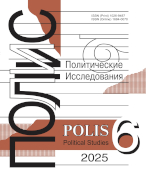Comparative Analysis of the Post-Communist Secessions:
The Prognostic Attempt of Quantification of the Factors` Impact on Secession
Tokarev A.A.,
Dr. Sci. (Polit. Sci.), Leading Researcher, Institute of International Studies, MGIMO University; Chief Researcher of the Laboratory “Youth Policy”, HSE University, Moscow, Russia, a.tokarev@inno.mgimo.ru
elibrary_id: 637634 | ORCID: 0000-0002-8196-0518 | RESEARCHER_ID: AAD-3009-2020
DOI: 10.17976/jpps/2017.04.08
Tokarev A.A. Comparative Analysis of the Post-Communist Secessions: The Prognostic Attempt of Quantification of the Factors` Impact on Secession. – Polis. Political Studies. 2017. No. 4. https://doi.org/10.17976/jpps/2017.04.08
The USSR and Yugoslavia collapses gave rise to aspirations of some administrative units to get autonomy of the former mother-state countries, achieving the status of really sovereign states. In both cases, the majority of secessions had an external patron-state, military conflict with the mother-state, obvious problems with internal sovereignty. Secession fulfilled attempts of the public administration, linguistic, ethnic and cultural identification. They sought to preserve the status within the USSR and Yugoslavia, in contrast to the mother-states. All these factors are common to post-Communist secessions, but each of them has the individual country characteristics. DPR and LPR polities are aimed at secession from the unitary Ukraine. The author proposes to consider it in comparison with the secession in the federations. He believes the processes around 2014-2016 years of the Russian-Ukrainian relations are the deferred influence of the Soviet Union collapse. The purpose of research is the forecast of the success of Donbass secession by means of quantification the degree of the factors` influence. 8 post-Communist secessions are compared by 10 bases, which are factors of secessions processes. Each of the 10 factors was assigned a numerical value on a scale from -3 to +3, depending on the importance of its impact on the success of secession. As a result, all the values are summed, showing the probability of the secession success. The author concludes that while the reduction of the two factors importance (1) the patron-state influence on the DPR and LPR state-building, (2) the control under common border with it, they will be unsuccessful secessions. DNR and LNR projects are leaders of the secession failure (-11 points) – the worst probable result is -19 points. The policy of the mother-state is aimed at reintegration, primarily the territories, but not to their citizens. It will most likely lead to the exodus of large numbers of refugees from the region. This will be followed by many years of value conflict between the residents of Donbass and Ukraine and will be a constant danger factor for the Ukrainian stateness.
References
Berg E., Mölder M. Who is Entitled to Earn Sovereignty? Legitimacy and Regime Support in Abkhazia and Nagorno-Karabakh. – Nations and Nationalism. 2012. Vol. 18. No. 3. P. 527-545. DOI: http://dx.doi.org/10.1111/j.1469-8129.2011.00527.x
Blakkisrud H., Kolstø P. Dynamics of De Facto Statehood: The South Caucasian De Facto States Between Secession and Sovereignty. – Southeast European and Black Sea Studies. 2012. Vol. 12. No. 2. Р. 281-298. DOI: http://dx.doi.org/10.1080/14683857.2012.686013
Fukuyama F. The Imperative of State-building. – Journal of Democracy. 2004. Vol. 15. No. 2. P. 17-31. DOI: https://doi.org/10.1353/jod.2004.0026
Gachechiladze R. Geopolitics in the South Caucasus: Local and External Players. – Geopolitics. 2002. Vol. 7. No. 1. Р. 113-138. DOI: http://dx.doi.org/10.1080/714000896
Kamilova S., Berg E. How Can De Facto State be Distinguished from the Puppet State? Analysis of Transnistrian-Russian Relations and Dependences. – The Estonian Foreign Policy Yearbook. Tallinn: Eesti Välispoliitika Instituut. 2011. Р. 151-182.
Kuthy D.W. The Effect of State Capacity on Democratic Transition and the Survival of New Democracies. Dissertation. Georgia State University. 2011. URL: http://scholarworks.gsu.edu/political_science_diss/20 (accessed 11.04.2017).
Malek M. State Failure in the South Caucasus: Proposals for an Analytical Framework. – Transition Studies Review. 2006. Vol. 13. No. 2. Р. 441-460. DOI: http://dx.doi.org/10.1007/s11300-006-0106-z
Roeder P.G. Where Nation-States Come From: Institutional Change in the Age of Nationalism. Princeton: Princeton University Press. 2007. 440 p.
Rotberg R. The New Nature of Nation-State Failure. – The Washington Quarterly. 2002. Vol. 25. No. 3. P. 85-96. DOI: https://doi.org/10.1162/01636600260046253
Rotberg R. Failed States, Collapsed States, Weak States: Causes and Indicators. – State Failure and State Weakness in a Time of Terror. Ed. by R.I. Rotberg. Washington, D.C.: Brookings Institution Press. 2003. P. 1-25.
Schmitter P., Wagemann C., Obydenkova A. Democratization and State Capacity. – X Congreso Internacional del CLAD sobre la Reforma del Estado y de la Administración Pública, October 18-21. 2005. Santiago, Chile. URL: http://unpan1.un.org/intradoc/groups/public/documents/clad/clad0052201.pdf (accessed 16.05.2017).
Ilyin M.V. The Formula of Statehood. – Politeia. 2008. No. 3. P. 67-78. (In Russ.) URL: http://politeia.ru/files/articles/rus/Politeia_Ilyin-2008-3.pdf (accessed 21.05.2017).
Kiva A.V., Fedorov V.A. Anatomy of Terrorism. – Obshchestvennye nauki i sovremennost’. 2003. No. 1. P. 130-142. (In Russ.) URL: http://ecsocman.hse.ru/data/069/769/1219/010Kiva.pdf (accessed 21.05.2017).
Popov F. From “Stateless Territory” to “De Facto State”. – International Trends. Vol. 9. No. 2. P. 5-17. (In Russ.) URL: http://www.intertrends.ru/twenty-sixth/003.htm (accessed 21.05.2017).
Tokarev A. National Project of Abkhazia. – Politcom.ru. 07.10.2013. (In Russ.) URL: http://www.politcom.ru/16510.html (accessed 21.05.2017).
See also:
Simonyan R.Kh.,
The Baltic States and the Disintegration of the USSR. – Polis. Political Studies. 2002. No6
Kazin F.A.,
Interrelations of Russia with South Ossetia and with Abkhazia in the Comparative Perspective. – Polis. Political Studies. 2009. No1
Goncharov D.V.,
Structure of territorial politics in Russia. – Polis. Political Studies. 2012. No3
Sukhar A.A.,
Ethnonational Conflict in Chechnya and in Kosovo: Comparative Analysis. – Polis. Political Studies. 2007. No4
Tokarev A.A.,
Labyrinths of the «Great migration». – Polis. Political Studies. 2014. No4




.jpg)






 print
print
.jpg)
.jpg)